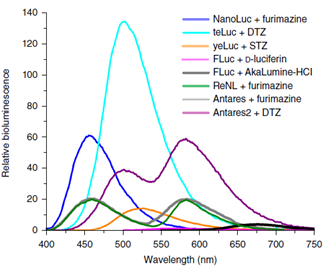The Brightest, Red-Shifted Luciferase-Luciferin Bioluminescent Pairs
- 技术应用
- These biocompatible, coenzyme free luciferase-luciferin pairs are able to emit orders of magnitude more light than common ones, while also being red-shifted, enabling the light to pass through thicker regions of mammalian tissue, enabling deeper and more reliable in vivo bioluminescence assays in medical applications
- 详细技术说明
- None
- *Abstract
-
Researchers at the University of California, Riverside, have developed several new luciferase-luciferin pairs that have superior brightness and excellent performance in vitro and in vivo. Through directed evolution of the existing NanoLuc Luciferase and the use of diphenylterazine (DTZ) as a substrate, the emission extensity is more than doubled compared to NanoLuc-furimazine. Moreover, red-shifted emission of teLuc-DTZ makes it an excellent tool for in vivo imaging. teLuc-DTZ streamlines a variety of applications to afford high sensitivity and reproducibility. Furthermore, fusing teLuc to a fluorescent protein creates the Antares2-DTZ pair, with emissions further red-shifted to the > 600 nm range and 65 times more photons emitted above 600 nm than FLuc-D-Luciferin.

Fig. 1 shows the relative emission intensity and the range of emitted wavelengths of light
- *IP Issue Date
- Mar 1, 2018
- *Principal Investigation
-
Name: Huiwang Ai
Department:
Name: Hsien-Wei Yeh
Department:
- 申请号码
- 20180057801
- 其他
-
Background
Bioluminescence imaging utilizes enzyme-substrate pairs to catalyze luminesence reactions, leading to photons at specific wavelengths using biocompatible reagents and without the need of excitation. Unfortunately, existing pairs have emissions orders of magnitude weaker than fluorescence due to low catalytic efficiency (such as Firefly Luciferase-Luciferin, or FLuc-D-luciferin). Other existing pairs such as NanoLuc-furimazine emit more photons than FLuc-D-luciferin, but mostly in the blue range, which is absorbed readily by mammalian tissues, limiting their usefulness for deep tissue imaging.
Tech ID/UC Case
29032/2016-710-0
Related Cases
2016-710-0
- 国家/地区
- 美国






